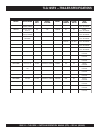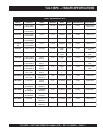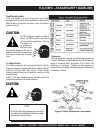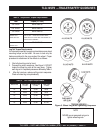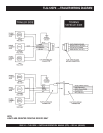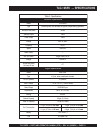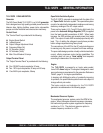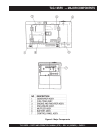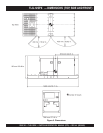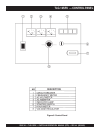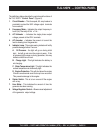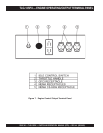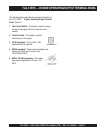
PAGE 20 — TLG-12SPX — PARTS AND OPERATION MANUAL (STD) — REV. #4 (03/08/05)
TLG-12SPX — GENERAL INFORMATION
TLG-12SPX FAMILIARIZATION
Generator
The MQ Power Model TLG-12SPX is a 9.6 kW
generator
that is designed as a high quality portable power source for
telecom sites, lighting facilities, power tools, submersible
pumps and other industrial and construction machinery.
Control Panel
The “Control Panel” is provided with the following:
Engine Speed Switch
Indicator panel
Output Voltage Adjustment Knob
Frequency Meter (Hz)
AC Ammeter (Amps)
AC Voltmeter (Volts)
Main Circuit Breaker 50 amps
Output Terminal Panel
The “Output Terminal Panel” is provided with the following:
One 120/240V output receptacle, 50 amp
Two 120V input receptacles, 20 amp and 30 amp
One 240V input receptacle, 30amp
Engine
The TLG-12SPX is powered by a 4 cycle, water cooled,
Isuzu 3LB1
diesel
engine. This engine is designed to meet
every performance requirement for the generator. Reference
Table 5, page 19 for engine specifications.
In keeping with Multiquip's policy of constantly improving
its products, the specifications quoted herein are subject to
change without prior notice.
The basic controls and indicators for the TLG-12SPX
generator are addressed on the following pages.
Mechanical Governor System
The mechanical governor system control the RPM of the
engine. When the engine demands increase or decrease,
the mechanical governor system regulates the frequency
variation to ±1.5%. The electronic governor option in-
creases frequency variation to ±.25%.
Open Delta Excitation System
The TLG-12SPX generator is equipped with the state of the
art "
Open-Delta
" excitation system. The open delta system
consist of an electrically independent winding wound among
stationary windings of the AC output section.
There are four leads: A, B, C and D. During light loads, the
power to the
Automatic Voltage Regulator
(AVR) is supplied
from the leads parallel connections of B&C. When loads
increase, the AVR switches and accepts power from leads
A&D. The output of leads A&D increase proportionally with
load. This of adding the voltages to each phase provides
better voltage response during heavy loads.
The connections of the AVR to the AC output windings are
for sensing only. No power is required from these windings.
The open-delta design provides virtually unlimited excitation
current, offering maximum motor starting capabilities. The
excitation does not have a "
fixed ceiling
" and responds
according the demands of the required load.



